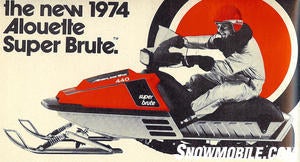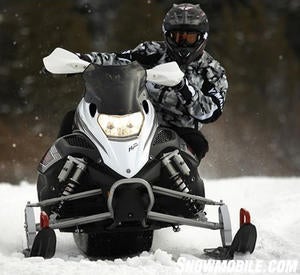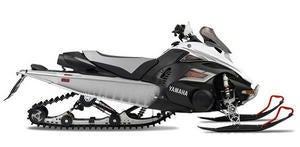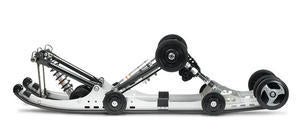Bassett’s Blog: Pros and cons of sled reviews

When fans of all brands think you're biased, then you know you're doing something write
Having test ridden and written about new sleds for quite a while now -officially since the 1974 Alouette Super Brute among others – it never fails that someone gets a bit offended by something you write. Over the years this writer has been condemned for being pro-Ski-Doo, pro-Arctic Cat, pro-Scorpion, pro-Kawasaki, pro-Polaris, pro-SnoJet, pro-Yamaha or pro-whatever. That comes with the territory when you write about powersports.
Having written for a million-circulation motorcycle magazine a number of years ago (or is it decades now?), my mail box (the old-fashioned kind) would get abused by anti-UJM (universal Japanese motorcycle) riders, namely Harley-Davidson types. At that time Harley guys were not the cadre of ‘bad boy’ accountants, lawyers, insurance salesmen and car dealers like they are today. They were the real deal knucklehead and panhead fans. As such they were highly agitated when our publication hit their mailbox. Anti-American, is what they thought. How could any writer possibly print positives about the UJM and denigrate their beloved Harleys? Now years later, this writer is a Harley rider, having come off the UJM and a Japanese Harley-esque cruiser.
The previous message goes to prove that snowmobilers are not alone in their brand loyalty. After all, during the recent Daytona 500, how many fans were glad that a Dodge finished first over the Toyota? Be honest, now.
Brand loyalty
 Back in the day we were probably Pro-Alouette.
Back in the day we were probably Pro-Alouette.Brand loyalty is what we have in snowmobiling. It plays a major role with riders. That’s why Polaris held on to Number One for more than a decade. The Indy was good, but was it the best in its last iterations? Even if it were not, the other manufacturers had problems convincing those die-hard, brand loyal riders to switch. It wasn’t until Polaris itself kept giving its ridership reasons to move elsewhere. Now Polaris is finding that those riders they lost are not automatically coming back to Polaris’ Roseau-made sleds—even though the latest crop of Polaris snowmobiles is as good as anything else out there on the trails.
Which leads me back to the beginning of being ‘pro-whatever.’ A snowmobile writer knows that he is doing his job if he receives comments that he is pro-Arctic Cat, pro-Polaris, pro-Ski-Doo or pro-Yamaha (or, conversely, anti all of the above). Especially if those comments come in the same week. Perfect. Opinions are simply that. Each rider, including us writers, needs to base his preferences on his own riding experience, then try to extrapolate a useful base line from other sources like the manufacturer and other riders. That’s how it is with test riding and writing impressions about sleds. If you are an 18-year-old snocross rider your impressions of a touring sled will be biased by your racing experience. If you are a 45-year-old touring rider, your impressions of a race replica sport sled will be influenced by your groomed trail values. And, of course, there is always the possibility that we writers sometimes get it flat wrong. It happens.
Impressions vary
Unlike everyday riders, we don’t get hundreds—if not thousands—of miles on each sled we test ride. At the Yamaha introduction this past January, we rode a variety of different models in a variety of setups for less than 100 miles total. Your impressions vary, especially when a manufacturer’s engineer or test technician informs you that a certain widget will be changed and that ride impressions will be different a month from your original ride. We try to moderate our impressions from the initial ‘ride and reveal until we move to sleds that are closer to production. Those test rides and impressions come about six weeks later when we ride all the models head-to-head against their competition. Even then changes happen to make sleds better—and worse.
When we first rode the original short track Polaris Fusion, it seemed obvious that the track profile was not aggressive enough. We got track spin almost all the way down a snow-packed quarter-mile test track. When we switched to the long tracked models, the engine power was obvious. And, just a few weeks later, when Polaris showed the Fusion at the springtime comparison event, there was a new, more aggressive track underneath it. Unfortunately for Polaris, the Fusion suffered other, more damning problems that ended up causing them to lose customers to the competition. Some are coming back, but not all.
Getting snookered
 Refinements to the front end make the XTX corner flatter than last year’s Nytro version.
Refinements to the front end make the XTX corner flatter than last year’s Nytro version.We’ve been snookered in the past—and expect that we will fall prey in the future. There were the famous 2002 Yamaha RX-1 speedometer readings. We remember seeing front pages of snowmobile magazines blurting out 120-plus miles per hour claims. The only problem is that Yamaha’s digital speedometers were highly optimistic and not terribly accurate past about 50 mph. We discovered this when we tested a production model with radar. We could never replicate those optimistic speedometer readings on our radar gun.
Arctic Cat snookered us one year. This was in a good way. The now forgotten EXT 550 with AWS actually turned out to be a much better production sled than prototype test sled. Cat’s engineers and test crews had fallen behind schedule and ended up using the annual photo/test ride session to fine tune that year’s model. Each day the Cats got better. By production, the Cats were spot on.
As a test rider and writer, you have to draw on these experiences and base some opinions and impressions on the differences you see and feel from the initial ‘reveal’ rides to the photo/test ride evaluations. Even then, you can be caught in a quandary as we were last season. The 2008 Yamaha Nytro underwent what we considered a very good transformation from the initial ride to the second series of test rides. We felt that weight transfer was abominable on the early test ride. The all-new Genesis 130 motor yanked the skis up in the air as the rear suspension failed to properly control front to rear transfer. A few weeks later, the issue seemed to have been settled, as was the front end.
Changing impressions
We expressed concern and reported so in our first writing about the Nytro last season. After our second session with the new Nytro, we reported that Yamaha had addressed the issue. Do you want to grab a full handful of throttle mid-turn and have the skis come off the snow? Sorry, we are not that adventurous any more. We like our skis to grip and the front end to remain grounded. Anyway, it would seem that Yamaha, after our second series of test rides, made changes for production that were a compromise in favor of less ski pressure and more ski jump. We understand that this potentially makes straight ahead running in moguls more fun for the pure ditch pounders. We felt that it took away from cornering power. We couldn’t help but notice that the all-new 2009 Nytro XTX reverts to more controlled front-to-rear weight transfer and that the sled corners flatter than the previous Nytro version.
 Note the seat, Yamaha says the seat is the same as that used on last season’s Nytro models. We say something has changed and we like the XTX seating better.
Note the seat, Yamaha says the seat is the same as that used on last season’s Nytro models. We say something has changed and we like the XTX seating better. We feel the 2009 XTX rear suspension transfers weight front-to-rear way better than the Nytro set up.
We feel the 2009 XTX rear suspension transfers weight front-to-rear way better than the Nytro set up.Corrections
Speaking of the new 2009 Nytro XTX, Yamaha spokesmen expressed concerns with our February 13th report. One concern was the weight issue. We did compare the 2009 Nytro XTX weight of 542 pounds versus the Ski-Doo MXZ 1200 X four-stroke at 509 pounds. Yamaha feels that an extended track to extended track comparison of four-stroke models will show the two sleds close in weight. We knew what the published weights for the XTX and the 1200X were. At this point we don’t know if there is a Ski-Doo Renegade with the four-stroke motor. But for 2008 there was a Ski-Doo Renegade with 800 PowerTek and weight listed as 445 pounds. Yamaha did not produce a ‘crossover’ version of its 2008 Nytro model. The 2008 Nytro RTX with a 121-inch track weighed in at 513 pounds—slightly heavier than the 2009 Ski-Doo 4stroke with its 121-inch track. We’ll have to wait and see about comparisons when all models come off embargo status and then we’ll know what claimed weights really are.
Yamaha also pointed out that the 2009 Nytro XTX uses the same seat as the previous Nytro series. We apologize for that, but even Yamaha admitted to confusion with the information on its XTX web site, which states:
“The FX Nytro XTX has a narrow seat for added comfort. In addition to putting the rider in a tall, forward, attack posture, the seat’s height makes it plush and comfortable for a full day of riding. The narrow seat sits atop the beveled tunnel, which allows the track to be a traditional 15 inches wide, to maximize traction.”
The implication is that the seat is new and improved. Based on our test ride, we still feel that some revision in seat dynamics has taken place, be it in foam layering or density. We like the 2009 seating over the previous generation. Maybe it’s simply the upgraded ergonomics that come with the new tunnel. Whatever, we prefer the XTX ‘ergoes.’
Opinions
Like you, we are not shy in having opinions. Lord knows snowmobilers are an opinionated group of enthusiasts. We have known folks from the various snowmobile manufacturers who would rather walk over hot coals barefoot than stand in their display booths to answer questions from snowmobile consumers. It would seem that such ‘free’ focus groups of users would give those who build the product a good insight into what should come in the future.
Snowmobilers have their opinions. We all have our biases. We are all pro-whatever. For this writer, let it be known that he is still a bit pro-Alouette because he appreciates just how far this snowmobile industry has come. There are no truly bad sleds anymore. You may like some better than others, but overall they all do about the same thing. That’s a good thing and it should make you pro-snowmobiling.
Related Reading:







 Your Privacy Choices
Your Privacy Choices